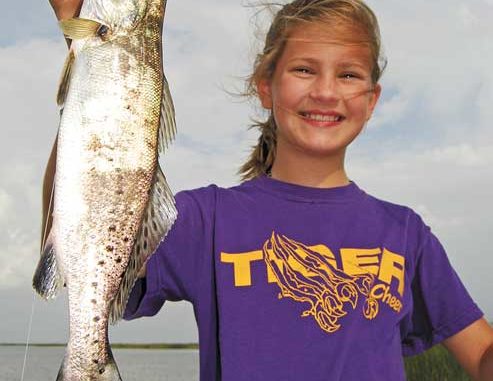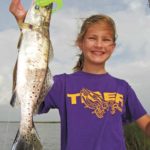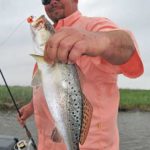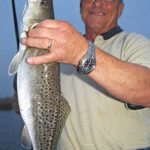
Fish Delacroix’s deep holes this time of year, and you’ll swear Santa Claus must be coming to town.
Our teeth should have been chattering.
We should have been bundled to our necks with long-johns, fleece pullovers, fluffy coveralls and heavy coats stuffed with the latest creation from DuPont chemists.
We should have been flipping our bails with frozen fingers and checking our rod guides for ice crystals.
After all, we were fishing the deepest holes in Oak River. We were dragging our baits across the oyster shell-caked bottoms, and we were catching trout like the water had suddenly turned to poison, and they just couldn’t wait to get out of it.
It had to be the heart of winter on the heels of a Canadian front.
Except it wasn’t.
Joe Richard, Marc Misuraca, Larry Frey and I were enjoying typical spring weather. A low cloud deck muted the strengthening sun. The air was delightfully warm — not scorching-hot like it would be in just a few weeks — and the wind, of course, blew through like it had a train to catch.
But despite the weather conditions, the fish were in the exact same places they were months earlier. They almost always are this time of year.
A striking difference, however, is the appearance of the fish. Trout pulled from these deep holes in the winter look like they should be on posters decrying neglect and exposure. Their bodies are too small for their heads, and they fight with all the gumption of wet dish rags. They seem in desperate need of a government bailout.
The springtime trout, on the other hand, are fatter than any AIG executive. In fact, their bellies can’t even hold all of the largesse available to them in these same holes that were so barren only months earlier. Catch one of these gluttonous trout, and you’re sure to see on the deck of your boat regurgitated evidence of what brought them back to the deep holes.
Baby croakers.
These tasty baitfish are like potato chips to speckled trout. They just can’t stop eating them. Wherever they find baby croakers, they’ll come back for more and more until their stomachs seem on the verge of bursting.
According to the book, Angler’s Guide to Fishes of the Gulf of Mexico, mature croakers spawn in offshore waters, and their eggs and larvae are carried inland by the tides. There, the juveniles eat microscopic zooplankton until they grow and get a hankering for some meat.
“At 2-5 inches they eat much less zooplankton and more small crabs, snails, clams, worms, insect larvae, small crustaceans and debris,” the book states.
One place they find all this is on the deep-water oyster reefs that are the hallmark of Delacroix’s winter fishing.
Who cares if it just happens to be spring?
Capt. Jeff Dauzat certainly doesn’t.
“People run all over those fish to go outside,” he said. “They’re passing up some of the best action anywhere.”
Dauzat regularly produces limits for his clients at these deepwater areas at a time when most anglers wouldn’t even dream of fishing anything other than bays.
“You don’t have to run to the Black Tanks to catch trout,” he said.
The action on the inside is so good, Dauzat doesn’t even have a trolling motor on his boat. He simply pulls up to his favorite holes, stabs the Cajun anchor into the bottom and bounces lures over the oysters.
“I fish spots,” he said. “I don’t necessarily go looking for fish.”
Dauzat explained that every one of these holes will have a sweet spot, a so-called “spot on the spot” that holds the majority of the fish in that particular location.
“You want to position your boat so you can cast to the sweet spot,” Dauzat said.
If Dauzat is fishing a new location, he may anchor several times to work the area thoroughly, looking for the magic spot.
“We’ve all had situations where we’ve pulled up to a spot we wanted to fish, and there was already a boat there catching fish,” he said. “They might be pulling them in one after another while you’re only able to get one here and one there.
“That’s because they’re in the ‘spot on the spot.’
“What you need to do is make a mental note of where they are and how they’re fishing, and come back either later in the day or on another day with similar conditions, and try to get in that spot.”
In areas with which he’s more familiar, Dauzat will anchor downcurrent of the sweet spot.
“You always want to be casting your baits so that you drag them with the current,” he said. “It’s more natural to the fish.”
This is particularly true this time of year. In the winter, the fish are in the deep holes because they provide protection from the harsh Arctic blasts. In the spring and summer, however, they’re there because the baitfish — primarily croakers — are there.
“The best holes this time of year are choke points and passes because they’re major migration routes for bait,” Dauzat said.
Depending on the strength of the currents, Dauzat will use 1/8- to 3/8-ounce jigheads teamed with Speck Buster soft-plastics.
“I want to fish the lightest I can get away with in any current,” he said. “On a light-tide day, that 1/8-ounce will let the bait kind of float up off the bottom. The fish may not be glued to the bottom; sometimes they’re suspended.”
Whereas in the winter, anglers want to work baits as slowly as possible to draw strikes from lethargic fish, deep-hole anglers this time of year need to give their lures some action. A croaker — or any baitfish — being swept along in warm spring currents will dart and dip and swim for its life when it sees trout rummaging like a pack of wolves.
Artificial lures should do the same to draw strikes.
“You want to keep your (rod) tip up, and work it from the 11 o’clock to 2 o’clock position,” Dauzat suggested. “In the winter, you kind of want to work the bait with the reel, but this time of year, you want to work the bait with the rod. You simply use the reel to take up the slack.”
Bites this time of year are also much different than in the winter. Cold-water specks mouth baits, and sit virtually still after the strike. Springtime fish, on the other hand, attack like starved piranha. Strikes are unmistakable.
To the angler holding the rod on the other end of that bait, the sensation is like having a brick dropped on your line.
And you can’t get that in the winter.







